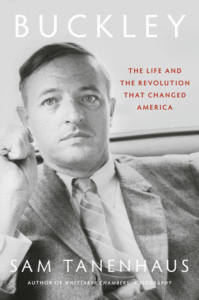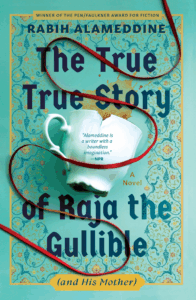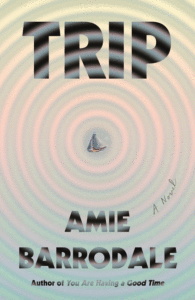
Our feast of fascinating reviews this week includes Grace Byron on Patricia Lockwood’s Will There Ever Be Another You, Becca Rothfeld on Amir Husain’s The Cybernetic Society, Osita Nwanevu on Sam Tanenhaus’ Buckley, David L. Ulin on The True True Story of Raja the Gullible (and His Mother), and Chelsea Leu on Amie Barrodale’s Trip.
“What will life be like after Twitter? Perhaps it’s too soon to say, but Lockwood attempts to find out in Will There Ever Be Another You, a claustrophobic travelogue of online and IRL adventures abounding with whimsical interludes, all packed taut with her signature wordplay. Deliriums blend together; fellow authors are characters and subjects; subjects and verbs are scrambled; oblique references are made to Outlander and Amazon.com and Property Brothers, a home-improvement show hosted by twins. As Lockwood flies from Paris to Key West to London, she writes a lyrical and barely legible journal of holy and sacrilegious feelings, a pocketbook emptied out in search of the nation’s plot.
…
“This is a novel about illness, travel, and death, and the porous nature between fact and fiction. It is a book about the struggle for language, about the snaking of proper nouns from the brain down to the tongue. Memory dilutes language. Each linguistic slip is a chance for Nabokovian adjectives to bloom, for Lockwood’s poetic puzzles to click into place.
…
“This is a pandemic novel unmarked by the nascent genre’s cliches of privilege and illness as a metaphor. Some recent books—like Sally Rooney’s Beautiful World, Where Are You—have gestured toward the time period in an epilogue, never working through what such world events actually mean for their characters. Sigrid Nunez’s The Vulnerables and Deborah Levy’s August Blue both failed to understand how class mediated their characters’ basically unwounded experiences of Covid. Chronicles of the era can all too easily feel like trauma porn—or worse, pretension masquerading as depth. Everyone became a first responder, ready to cast the blame anywhere collectively but nowhere interpersonally. Such suffering, turned inward, can spiral. Lockwood, however, manages to explicate the harried, nonsensical, grief-soaked timeline with acrobatic skill.
…
“Some experiences, some books, are not meant to be picked apart. They are watercolor gouaches that wash over us as we delight in a palimpsest of colorful impressions. Patricia Lockwood’s body of work is like this: a hymn—or ode, depending on the day—to the painful project of being human.”
–Grace Byron on Patricia Lockwood’s Will There Ever Be Another You (The New Republic)

“Sometimes an era is graced with a gift—a book that is not merely deficient in the usual ways, not merely insipid or uninspired, but epochal in its ineptitude. Amir Husain’s The Cybernetic Society: How Humans and Machines Will Shape the Future Together is dull, convoluted and written in the glib and ingratiating tones of a TED Talk. So far, so unexceptional. But it is also something more painful for its readers and more interesting for its critics: a monument to the vapidity and vulgarity of the culture that incubated it. The latest from ‘serial entrepreneur,’ tech company founder and unabashed AI apologist Husain, The Cybernetic Society is hard to summarize for the same reasons that it is aggravating to read. It is a scramble of futuristic fantasies, presented in a nonlinear frenzy. One chapter imagines how brain-computer interfaces will usher us into virtual reality; another suggests that AI should run companies. Throughout, Husain delves into technological minutiae that don’t end up mattering to the overall arc of his argument—insofar as his scattered nattering can be dignified with such a word.
…
“…the most serious problem with The Cybernetic Society is reflected in its shallow style. Husain writes as if he is leading a board meeting or interviewing for a job at McKinsey. He is fond of alliterative gimmicks that lend his formless thoughts the erroneous appearance of organization.
…
“That someone could oppose a development on robust political or philosophical grounds is almost inconceivable to Husain. In his world, nearly all problems are technical problems to be ironed out by more advanced AI or, at worst, regulatory problems to be mitigated by a few minor legal or logistical shifts. The only truly political quandary in The Cybernetic Society is how to get AI into everyone’s hands—so that we can outsource any future political confusions to the machines.
…
“If we are called upon to justify our existence in terms of utility, we have already lost. Human life is the greatest inconvenience of all. It would be vastly more convenient to simply be dead or, better yet, to never have been born. The ideal world, per Husain’s logic, would consist of computers talking to one another, running our companies and our cities, while we sit unobtrusively in some dark corner gazing into our VR headsets and, presumably, basking in the glow of all our ‘safety’ and ‘livability.’ I confess that I prefer a rousing bout of unlivability on occasion. But then, I am an old-fashioned partisan of that gloriously unoptimizable inefficiency: the human being.”
–Becca Rothfeld on Amir Husain’s The Cybernetic Society: How Humans and Machines Will Shape the Future Together (The Washington Post)

“Whatever his flaws, they say, Buckley brought an enlightened conservative movement into being, one that has since been debased by figures like Trump and his sycophants. As Tanenhaus understands well, the stakes of Buckley—a book that was about three decades in the making and weighs it—are that it might help us make sense of the turn toward Trumpism and the character of the American right more broadly.
…
“On the whole Tanenhaus’s portrait of Buckley’s later views and activities is sketchy. Only a few dozen of the book’s more than eight hundred pages of body text are dedicated to the last twenty or so years of his life. But the story Tanenhaus most wants to tell—the rise and rise of Buckley and his movement—ends in the mid-1980s. He tells that story richly, giving life to a host of confidants and confederates just as fascinating, including conservative luminaries like Willmoore Kendall and Whittaker Chambers and less heralded figures like the mercurial, mudslinging ex-Communist Willi Schlamm, who helped shape National Review before falling out with Buckley, and Bozell, who left Buckley’s camp even more dramatically as he fell further into radical antiabortion activism and mental illness. The conservative movement, Tanenhaus makes clear, was the product of many hands. The vision of Buckley as its leader that emerges from his narrative is one not of a commanding general but of a baton twirler at the head of a long procession.
…
“Many who never bought Buckley’s conservatism were sold on the fantasy of public discourse he offered—the noise and tumult of politics reduced to the volume of parlor discussion. But for all the cordiality he and his guests displayed while chatting about the issues driving America apart, the country was, in fact, being driven apart. A larger, more impressive crop of public intellectuals and a more edifying political media were able to speak more ably to that moment’s discord than ours can now, but they could not tame it. As eloquent as Buckley and his peers were, their finely chosen words and manners did not prevent the seeds of our current political climate from taking root.”
–Osita Nwanevu on Sam Tanenhaus’ Buckley: The Life and the Revolution That Changed America (The New York Review of Books)

“It is hard to do justice to Rabih Alameddine’s seventh novel…without giving too much away. The book functions as a set of nesting dolls, offering stories embedded in stories, a series of overlapping detours and evasions that ultimately coalesce as a vivid and coherent whole. In that sense, the novel is as much about the storyteller, or the process of storytelling, as it is about the substance of its narrative. Imagine a 21st-century Scheherazade—in the form of a 63-year-old gay Beiruti teacher named Raja—spinning stories to keep himself and his 85-year-old mother alive in a dangerous and disruptive world.
To facilitate such a mix, Alameddine constructs The True True Story of Raja the Gullible like an accordion, bracketing it with two short chapters set in 2023 and using the space between them to take his narrator back and forth in time. One story, or memory, leads to another as the novel telescopes and folds in on itself. The result is a book of willful delirium, one that deconstructs its own narrative. Alameddine has long worked with innovative structures; his 2001 novel, I, the Divine, unfolds as a series of first chapters. Twenty-four years later, the shape of this new work of fiction highlights both the insufficiency of memory, of story, and their utter necessity.
…
“What Alameddine is suggesting is that truth is subjective, which means writers are liars if anything at all. While a narrative may appear to move toward order, this is a frame we impose afterward. In the moment, there is just chaos. In the moment, there is only circumstance. That’s a point Alameddine makes explicit throughout The True True Story of Raja the Gullible, as he constantly feints and weaves to undermine his narrator’s authority.
…
“Because here’s the thing: Alameddine is playing the long game in The True True Story of Raja the Gullible, trusting that we’ll stay with him, that the skill and urgency of his storytelling will keep us rooted, let him pursue his own pace. This, too, is the way of life, a series of moments followed by other moments, the connections only apparent through the passage of time. Where else does such a passage take place if not within us, where we are always every age we have ever been at once? It’s a tightrope walk, a magic trick, which is also what a novel is. A tale with many tails and heads that is, in this case, magnificently articulated through the instrument of Raja’s voice.”
–David L. Ulin on Rabih Alameddine’s The True True Story of Raja the Gullible (and His Mother) (Alta)

“This relationship between mother and son forms the emotional core of the book, a steadying source of clarity amid the story’s wilder details. Again and again, among a series of disjointed visions, Sandra returns to her memories of Trip’s childhood: the first inklings of his autism, his diagnosis, the endless meetings with teachers and therapists and school administrators.
Beneath the otherworldly projections of bloated zombies and necrotic hands, the reader starts to sense that these memories constitute Sandra’s unfinished business, attachments she must move beyond. They’re suffused with her regret that she could have done more to help her son, and her helpless rage at the professionals who suggest that there’s something wrong with him.
…
“These dizzying, bizarre details are relayed in a matter-of-fact deadpan that leaves the reader never quite sure how to feel about what’s happening. Even as I marveled at Barrodale’s inventiveness, her gift for capturing the absurd specificity of an overheard Zoom meeting or texts from a dog-sitter, I couldn’t shake off a quiet but persistent disorientation. I just don’t get it, I would find myself thinking with some impatience, while reading yet another inexplicable scene.
And yet, by the end, my confusion and annoyance almost felt like the point. Perhaps there’s something salutary about being thrown off-balance, the novel suggests.
…
“In this light, the novel’s strangeness comes to seem entirely intentional, and brilliant. Trip captures something of how it might feel to have your brain work differently from everyone else’s, the loneliness and alienation of it. The story’s inscrutable moments even take on a sort of beauty. Like Sandra, the reader is asked to let go of the pinched need to have it all make sense, all the time—to instead open our eyes and simply see what’s there, in all its irreducible mystery.”
–Chelsea Leu on Amie Barrodale’s Trip (The New York Times Book Review)

